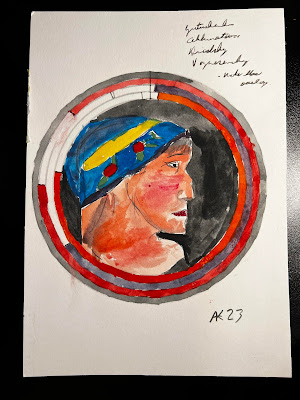It's been a busy winter and early spring, and I'm three weeks into the spring term teaching my data visualization class for the Maryland Institute College of Art. Having been teaching in the program for almost two years now, I continue to be impressed every day by the breadth of the students' experience and their real commitment to using data to tell stories in the form of insightful images. Every time I teach, I'm blown away by their class projects that often address an important societal or public policy issue.
With all the emerging technology around visualizing data, the notion that you don't need to know how to code or use an application like Tableau or Figma to build a good visual. In fact, sometimes we leave people behind when we act as though the only place to show visuals is on a screen. Data visuals that are painted or hand drawn are a time-honored tradition, from the historical visualizations of Charles Minard and Florence Nightingale to the graphics that W.E.B. DuBois made for the 1900 Paris Exposition.
I think we in the data visualization profession often fail to acknowledge that when we create very complex, interactive graphics, especially ones that use huge amounts of data, the amount of information and cognitive load that they demand from audiences is just too much. I think we need to look more at how to tell stories using data in ways that don't require comfort with computers and working online, both from the standpoint of accessibility and intergenerational equity.
I've been exploring data visualization paintings for a while now, starting out with baseball themes but when I mentioned this to the class this past week, to my surprise they asked to see what I was working on now. I shared them for a few minutes but have more space to share my current piece, and talk about how it came about.
In college, I was a Russian studies minor. This was in the early 1990s during a very different time in Russian-American relations, when the Soviet Union had just fallen, Boris Yeltsin was holding summits with Bill Clinton, and there was an air of optimism throughout the world. My mother and late sister both were avid ballet dancers. Even though I never had the actual ability to dance, I grew up knowing The Nutcracker, Swan Lake, and the great Russian composers very well, and when I got to Penn I started taking Russian language classes. I came quickly to love the great Anna Akhmatova, whose career spanned the last years of the Tsar, the civil war, and Stalin's purges. She was a mentor to the "shestidesyatniki", the poets of the 1960s like Andrei Voznesensky, Yevgeny Yevtushenko, and Joseph Brodsky.
While I was at Penn, I went to readings with Voznesensky and Yevtushenko, multiple times in the case of the latter (during which his style of dress became more and more elegant, moving from a metallic copper leisure suit to a dapper double breasted suit), and a joint reading with the former with Allen Ginsberg. I can remember coming back to my dorm and enthusiastically calling home to tell my mom that I had just heard Ginsberg read from "Kaddish". Later during his visit, Voznesensky came to read at the Philomathean Society, Penn's 200-year old literary society, and I asked him about his motivation for writing "I Am Goya". (Much to my surprise, his choice of Goya had nothing to do with the Spanish artist's bizarre notebooks and more about the alliteration in the original Russian, where the title of the poem is "Ya Goya".
All of these poets made a huge impression on me. I still have the inscribed copy of "Russian Poets of the Silver Age that Yevtushenko signed for me nearly thirty years ago. He and Voznesensky are both with the ages now, but it's always struck me how those two giants of poetry, along with Brodsky, began their careers in Akhmatova's salon.
One of the great tools of data visualization is its ability to show relationships over time, and I wanted to show both the overlap of the four poets' careers and the breadth of the whole history that they witnessed: 112 years from 1905 (the beginning of Akhmatova's writing career) to 2017 (the death of Yevtushenko).
I started by laying out their careers in concentric circles, translating each year to 3.21 degrees (360 degrees/112 years) and using a protractor to sketch out the first study. Getting the data portion of the study to work took a couple of iterations, but I was happy enough with the final result to move to a final painting in acrylics. (In my initial analysis, I included Aleksandr Blok and Marina Tsvetaeva, but I left them out of the final painting. Though both of them are wonderful, and Blok's "The Twelve" is an incredible example of Silver Age poetry.)
Once I got the timelines right in the second study, I was happy with the general approach. The concentric arcs are reminiscent of Soviet-era propaganda posters and art. (I say this as an admirer of the style, and not because I have any affinity to the ideology that they represented.) The bold colors and shapes are also often seen in the art of Kasmir Malevich, who was active in the 1920s. I also painted the background in gold, again hearkening to old Russian icons.




Comments
Post a Comment